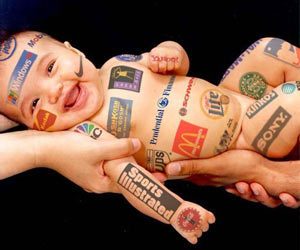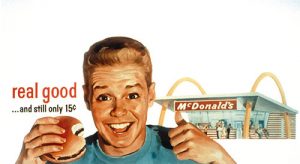# Advertising, collective term for public announcements designed to promote the sale of specific commodities or services. Advertising is a form of mass selling, employed when the use of direct, person-to-person selling is impractical, impossible, or simply inefficient. It is to be distinguished from other activities intended to persuade the public, such as propaganda, publicity, and public relations. Advertising techniques range in complexity from the publishing of simple, straightforward notices in the classified-advertising columns of newspapers to the concerted use of newspapers, magazines, television, radio, direct mail, and other communications media in the course of a single advertising campaign. From its unsophisticated beginnings in ancient times, advertising has burgeoned into a worldwide industry. In the U.S. alone in the late 1980s, approximately $120 billion was spent in a single year on advertising to influence the purchase of commodities and services.
# American advertising leads the world not only in volume of business but in the complexity of its organization and of its procedures
# A relatively minor, but important, form of advertising is institutional advertising, which is designed solely to build prestige and public respect for particular business concerns as
# Another minor, but increasingly popular, form of advertising is cooperative advertising, in which the manufacturer shares the expense of local radio or newspaper advertising with the retailer who signs the advertisement.
# Newspapers have traditionally led all other media in the U.S. in terms of dollars invested in advertising; despite the popularity of radio and television, the daily papers have maintained a comfortable lead. Thus, in 1987 newspapers received about 27 percent of the advertising investment in the nation, totaling more than $29.4 billion from local and national advertisers. In second place was television, with about 21 percent or approximately $23.5 billion. More than $19 billion was invested in direct mail. Radio received approximately $7.2 billion, and magazines got about $6 billion.
 TECHNIQUES OF PERSUASION
TECHNIQUES OF PERSUASION
# While experts argue about new methods, they still rely mainly on basic appeals that have proved successful over the years. These appeals offer the hope of more money and better jobs, security against the hazards of old age and illness, popularity and personal prestige, praise from others, more comfort, increased enjoyment, social advancement, improved appearance, and better health. The modern advertiser stresses not the product but the benefits that may be enjoyed by purchasers. Thus, the advertiser purveys not cosmetics but the expectation of new beauty, allure, and hope. To attract the prospective buyer of automobiles, the manufacturer may stress not only the mechanical attributes of the car but also the excitement, comfort, and prestige it may bring the buyer.
# The many techniques of persuasion are circumscribed only by the ingenuity of the creative mind, by the limits of the various channels of communications, by certain legal restrictions, and by standards self-imposed by the advertising industry. One fundamental technique, apparent in the earliest applications of advertising and still basic in the most modern procedures, is repetition. A typical national advertiser captures the attention of prospective customers by repeated appeals to buy. It is not unusual for a person to hear sales talks on radio and television, see advertisements for the same product in a local newspaper, receive additional reminders in various national magazines, and be confronted with a poster, counter card, or display on entering a store.
Another basic persuader is the trademark. Manufacturers have spent millions to establish their trademarks as symbols of reliability and value. A trademark is useless unless the manufacturer sets and maintains high standards of quality, but once consumers gain confidence in it, the owner can use it as a persuader, that is, as a device to reassure customers that all products bearing this symbol are reliable. The trademark is especially useful when the manufacturer introduces a new item to an existing line of goods.
Price appeal probably motivates more decisions to buy than any other appeal, and the magic words sale and bargain are directed at consumers with great frequency. Closely allied to these plain and simple discount offers are the “something for nothing” lures, such as “buy one package and get a second one free,” “send for free sample,” and “trial offer at half price” and the big-money contest, for example, “finish this sentence and win $10,000 in cash, an automobile, or a trip to Bermuda for two.” “No money down” is also a successful inducement.
 Modern advertising employs an astonishing variety of persuaders. Among these are humorous and entertaining television and radio commercials, appeals to the sense of smell by the use of perfumed ink on paper, endorsements of products by celebrities, appeals to parents to give their children a better life and future, appeals to children to “ask mommy” to buy certain breakfast cereals, and the controversial use of “scare copy.” Because fear is a principal human frailty, this last-mentioned motivation is applied to the advertising of thousands of commodities, sometimes boldly, sometimes subtly. Fear of poverty, sickness, and loss of social standing, and the specter of possible disasters, great and small, sometimes move previously unexcitable consumers to buy anything from insurance and fire extinguishers to cosmetics and vitamin capsules.
Modern advertising employs an astonishing variety of persuaders. Among these are humorous and entertaining television and radio commercials, appeals to the sense of smell by the use of perfumed ink on paper, endorsements of products by celebrities, appeals to parents to give their children a better life and future, appeals to children to “ask mommy” to buy certain breakfast cereals, and the controversial use of “scare copy.” Because fear is a principal human frailty, this last-mentioned motivation is applied to the advertising of thousands of commodities, sometimes boldly, sometimes subtly. Fear of poverty, sickness, and loss of social standing, and the specter of possible disasters, great and small, sometimes move previously unexcitable consumers to buy anything from insurance and fire extinguishers to cosmetics and vitamin capsules.
ECONOMIC AND SOCIAL EFFECTS
With about 3 million business enterprises using one or more forms of advertising, almost every American citizen hears or sees advertising every day. In the U.S. the money invested in advertising equaled approximately $370 per capita in the mid-1980s. The high per capita cost of U.S. advertising has led many critics to attack it as a wasteful, unnecessary, unreliable, and annoying institution. Such critics usually argue that the industry adds unnecessarily to the cost of goods and services promoted by it. The proponents of advertising recognize some validity in these criticisms, but in rebuttal argue that by interesting consumers in purchasing commodities, advertising enables manufacturers and others to sell their products in larger quantities than they would otherwise; the increased volume of sales in turn enables companies to sell individual units at lower cost than if they were produced in small quantities.
In the opinion of most top business executives and of many economists, modern advertising plays an integral role in the development of markets for the low-cost goods made possible by the high productivity of American industry. At least one worldwide study of national investment in advertising, which showed a direct correlation with living standards, supported this thesis.
Advertising also supplies most of the operating funds of the principal communications media. According to an authoritative survey, the radio and television industry depends on advertising for all its revenue. Metropolitan newspapers derive about 70 percent of their income from advertising, and national magazines, some 60 percent.
The Mirror Makers
Many advertisements focused on Jordan’s determination to succeed and encouraged kids to “be like Mike.” Subliminal perception aroused considerable public interest after it was reported that in 1957 a motion picture theater in New Jersey had flashed subliminal advertising messages on its movie screen. These messages, urging the audience to “Eat popcorn” and “Drink Coca-Cola” were alleged to have been flashed on the screen so quickly that the viewers were not aware of having seen them. Nevertheless, the theater reported that its sales of popcorn and Coca-Cola noticeably increased after the messages were presented. There was considerable public outcry against this form of so-called hidden advertising, and major radio and television networks banned all forms of subliminal advertising. However, later investigators suggested these findings were fabricated as a publicity stunt. Advertisers spend more of their money advertising in newspapers than in any other medium. Newspapers offer two different types of advertisements: display ads and classified ads. Display ads share page space with news and features. They generally feature illustrations, photographs, or catchy phrases in large print to attract the attention of readers.
Teams of specialists sell newspaper display ads to local and national businesses. Advertisers pay based on how much space their ad requires on the page. They can purchase full-page display ads, which fill an entire page of the newspaper, or fractions of pages. The price of an advertisement depends on the size of the newspaper’s circulation. A full-page display ad in the Wall Street Journal, for example, cost nearly $150,000 in 1999. Newspapers with smaller circulations charge less for display ad space because companies assume that fewer people will see their advertisements. A full-page display ad in a weekday edition of the Seattle Times, which had a circulation of about 230,000 in 1999, cost up to $23,800.
 During the 1960s, McDonald’s began to mount aggressive advertising and marketing campaigns. In 1962 the company adopted the golden arches as its trademark. Ronald McDonald, the familiar clown that serves as McDonald’s mascot, was introduced in 1963. That year, signs at McDonald’s restaurants announced that the company had sold more than 1 billion hamburgers. In 1968 McDonald’s restaurants began serving the Big Mac, a two-patty burger that became the company’s flagship product. The company launched it’s highly successful “You deserve a break today” advertising campaign in 1970. By 1972 McDonald’s had 2000 restaurants and $1 billion in annual sales.
During the 1960s, McDonald’s began to mount aggressive advertising and marketing campaigns. In 1962 the company adopted the golden arches as its trademark. Ronald McDonald, the familiar clown that serves as McDonald’s mascot, was introduced in 1963. That year, signs at McDonald’s restaurants announced that the company had sold more than 1 billion hamburgers. In 1968 McDonald’s restaurants began serving the Big Mac, a two-patty burger that became the company’s flagship product. The company launched it’s highly successful “You deserve a break today” advertising campaign in 1970. By 1972 McDonald’s had 2000 restaurants and $1 billion in annual sales.
– Rishav Bashyal










































